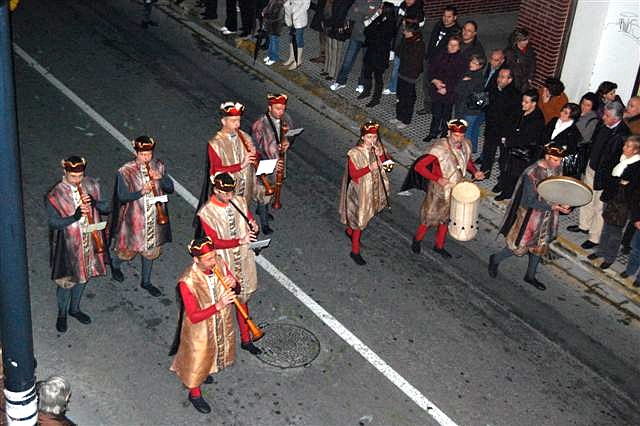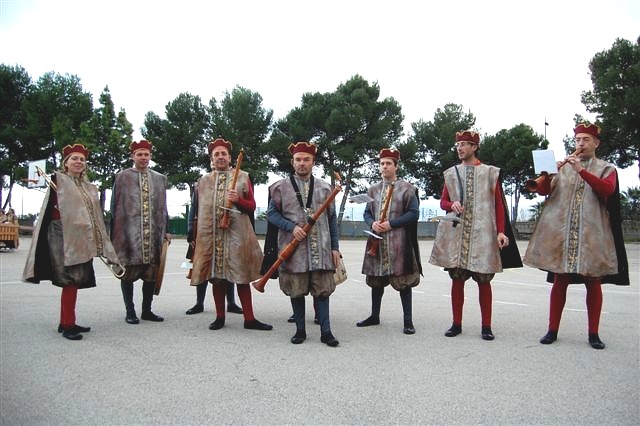Ensemble de Ministrils Ciutat de Gandía
This will be the first time that Ensemble de Ministrils Ciutat de Gandía join us for a Waites Festival. Here is a little more information about their group.
In 2007 Frederic Santamaría had the idea to begin a shawm band to interpret Renaissance music. Frederic’s enthusiasm soon spread to other musicians within the Association of Dulcians and Tabaleteros(Drummers) in the Safor Region, and recruited musicians there. the first step was to choose instrument makers and acquire suitable Renaissance instruments. The next step was to amass a suitable repertoire and to plan rehearsals. When all was ready, rehearsals began for their first public performance. This included three soprano shawms, one Alto and one Tenor with two percussionists.
Ensemble de Ministrils Ciutat de Gandía
2007 – Their first concert was in the Ducal Palace of Borja, to announce the Literary Award of the City of Gandía.
2008 – They took part in Holy Week at the Fair of Gandía, accompanied the Borgia family and the Literary Awards’ Joanot Martorell.
2009 – The Ensemble added two instruments typical of the era – a Sackbut and a Cornetto.
2010 – The 5th Centenary of the birth of Francisco de Borja – Gandía City held a series of events as Cabalgatas (similar to processions) and Concerts, some early in the year and others as Cabalgata de los Clásicos in the months of July and August, and several Concerts in the months of September, October, November and December. In the Via Crucis of Easter 2010 the group accompanied the Brotherhood of the Holy Ecce Homo of Gandía. Currently the components of the group are:
Sopranino and Soprano Shawm: José Maria Bataller
Soprano Shawm: Joan Grau and Andres Puig
Alto shawm: Frederic Santamaría
Tenor Shawm: Miquel Ruiz
Sackbut: Mayte Sanz
Cornetto: Alexis Plana
Percussion: José Eduardo Basset and Morant
Visitatio Sepulchri
Here’s some more about the “Visitatio Sepulchri” miracle play of Gandía that the Ministrils of Gandía play for, even performing it in Rome later this year.
Video of Ensemble de Ministrils Ciutat de Gandía on YouTube
August 14th: Visitatio Sepulchri – Sant Francesc de Borja
In English: (with a traductor)
The Visitatio Sepulchri Gandía
Since 1550 until 1865, was held at Easter in the monastery of Santa Clara de Gandía a picturesque Visitatio Sepulchri with polyphonic music attributed to St. Francis Borgia. It appears that in 1550, before they go to Rome, met our patron saint of the collegiate chapter to set the rules for carrying out the representation and assign an amount to cover the annual expenses of the act.
For over 300 years, thanks to the donations of the Borgias and their descendants, the two of Osuna was represented at the Visitatio Gandía, until 1865, the Archbishop of Valencia D. Mariano Barrio attended a performance of drama, following a liturgical pastoral visit to the city. When asked for the privilege that Pope Alexander VI had granted to Clare to retain the most holy in his monument from Holy Thursday until Easter Sunday, could not readily show. It seems that one of the nuns had a habit of spending old documents to ignite the fires of the kitchen and between them had burned the papal Bula. The Visitatio was banned despite attempts to obtain a new papal privilege (although the record of the council can be found on 24 April 1868, an agreement that is taken by the plenary resolution writing petition the pope to again give the Bula).
But what is Visitatio Sepulchri?
The Visitatio is a trope, a brief interlude in the dramatic interludes to explain the liturgy. We take into account the time it is born, the tenth century Practically totafitat population is illiterate.
The murals give life to the churches and explain the biblical scenes. Pantocrator, evangelists, virgins, angels and saints come to life through them. But we must also give them voice, volume and movement. Is one of the Gospels and the characters, come alive in the liturgy to illustrate what the Latin is incomprehensible to almost everyone. The officiant begins to pray over interpreted. The plot is simple: in the office of Easter, the priest, taking the role of angel receives three other priests and complained.
Does it burn quaeritis in tombs, or Christicolae?
The three priests representing the three Maries, who went to anoint the body of Christ in the tomb, answered:
Jesum Nazarenum crucifixurn or caelicola!
Raising a cloth that covers a cross, the officiating that angel answered:
Non est hic: Sicut surrexit praedixerat. Ite, t nunti Quia surrexit of sepulchro!
Thus was born the liturgical drama. Over the years, the plot, so simple, was enriched with new characters and actions have to be more complex. There are talks among the three Maries (Magdalena, the Mayor of Santiago and the Virgin), appear seller of ointments, the apostles Peter and John, Christ himself, disguised as a reed, and others.
Until the sixteenth century, when the drama had fallen into disuse and no longer represented in almost anywhere, was born in Gandía with unique features.
On Easter Sunday, at five o’clock in the morning, surrounded by the first light of day, a procession left the Collegiate and went to Santa Clara streets that had been previously decorated with enramadas of myrtle, laurel and other herbs. During the journey the craft of singing responsories of darkness, typical of Easter. On arriving at the convent, the doors were closed. Inside, two angels asked the singing duo who looked into the tomb chapel of the choir, singing in four voices answer that came to worship the body of Christ in the Sepulchre. The angels replied that he was not who had ressucitat. The heart and insists that want to enter a priest, three times hitting the door with a cross until it is opened and the group enters.
Already within the church, and St. John appear to sing two Maries wondering who moved the stone that closed the tomb. Approach the monument and discovered the body of Christ is not there. Then sing three times (one for each of the three steps that descend again that the monument now Fescala) the “Surrexit Christus” (Christ revives!) The heart, catch her joy in seven voices answered: Alleluia! Alleluia! and all the entourage returned to his singing on the streets that Christ has ressucitat alternating plainsong with four voices.
I think that the recovery of a liturgical drama that was performed over three centuries in Gandía is important. Both from the religious point of view as to the recovery of a valuable cultural heritage of our hits.


